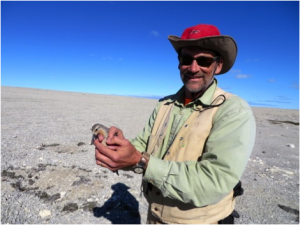Update from the Arctic #5: Knots at Last
CWF’s Larry Niles is in Northern Canada searching for Red Knots and other shorebirds in their Arctic breeding territory. We are following him and posting summaries of his blog entries as he reports from the field.


After 10 days in the field, 5 of them searching for knots, and with only one day before we must leave, we have at long last found knot nests – two, in fact. As we suspected, both still contained eggs, although one adult was also brooding a chick that was only hours old. Also as we suspected, we found them on small ridges in gravel-sized frost-cracked rock with very sparse vegetation.

There are fewer knots than the number of potential knot nesting sites in our study area, meaning the knots have two possible strategies when they choose a nesting site: they could be fanning out at very low densities, or they could be clustering and keeping a certain distance apart. Our experience at our first red knot study site suggested the latter possibility. In the first few years, when knot populations were still fairly high, knots occurred along ridges one kilometer apart. This fell apart as the number of knots collapsed in the period between 1999 to 2006, but our experience suggested knots will stay together and keep territories of about one square kilometer. In other words, knots like their space, but they still want neighbors.
So after finding the first nest, we started searching about 1 km away in adjacent habitat and soon found a second nest, corroborating our theory. But by then it was close to the end of the day and we had only an hour or so to search for a third. Finding none, we rode the 4 miles of hard trail back to camp with some satisfaction. We will try again tomorrow to find more in the area, but unfortunately it will be our last day.

Rain is falling against our tent, as it has through most of the night. Rain in the Arctic is always cold – more of a winter rain than one of summer. The knot nest with one chick will almost certainly have four by now, as it usually only takes 24 hours for all eggs to hatch. The adult will brood the chicks as best he can, but it’s not unusual for weather such as this to kill young shorebirds. This is one of many reasons why northbound stopovers like Delaware Bay must provide shorebirds with a good start every year.

If the rain abates, we will continue searching for nests tomorrow, but only time will tell whether our final day in the field will be a washout. Regardless, it is a wonderful feeling to have finally found what we came searching for.
For the full blog entry, see Larry’s post here.
Stay tuned for further updates!
Discover more from Conserve Wildlife Foundation of NJ
Subscribe to get the latest posts sent to your email.